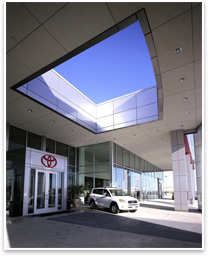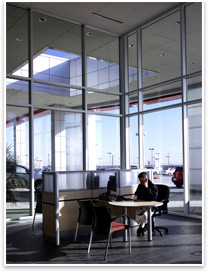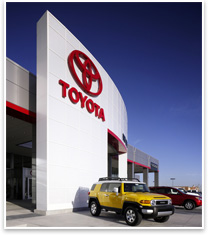
Gensler Achieves First LEED-Silver Auto Dealership How do you . . . incorporate sustainability into a seemingly incompatible building type?
The Gensler team, led by Studio Director and Automotive Practice Area Leader Rick Ferrara, AIA, promised not to put bells and whistles on the dealership and to forgo strategies without practical payback in a reasonable amount of time for business owner Pat Lobb, unless he directed otherwise. “We said you can’t slow down the design and construction process, and any unusual expenditures of money had to have a return on investment study that shows a reasonable payback,” Lobb said. He defined “reasonable” as three to five years. The total project cost was about $8 million for the 56,000-square-foot facility. The LEED premium was less than $400,000, and the additional cost has a return on investment of about three to five years. “He’ll be in the building much longer than that, so he’s invested in his building and in himself. Everything we did there has a really good economic story to tell,” Ferrara says. “We were able to take a building type that most thought was 100 percent incompatible with sustainable design and show sustainability can be made part of any project type.”
Other elements include:
“This project gave us is the ability to interact with the general public about sustainable design, and also architecture as a bigger idea,” Ferrara says. “It has really connected people better to buildings and to a sense of what architects are capable of doing.” Gung-ho for sustainable architecture
The process yielded new ideas, such as the notion they could hang a suspended ceiling in the tech shop. Yes, there would be an upfront cost, but it would result in smaller air-conditioning units and fewer of them, which would be cheaper to buy and operate. The tech shop also became a magnet for potential employees. The architects conducted a lot of face-to-face meetings, Ferrara noted, saying it’s crucial for the full team to be committed to the sustainable project. “It’s mostly attitude, but it’s vital that our contractors are as committed to sustainability as we are.” |
||
Copyright 2007 The American Institute of Architects. All rights reserved. Home Page |
||
home
news headlines
practice
business
design
recent related
› OHSU Center First Medical Facility to Win LEED Platinum Award
› California Academy of Sciences Evolving Green
See the Lobb Toyota Web site for a video on the dealership's design and construction. The dealership is attracting visitors from around the globe.
Ferrara is now working on a LEED-Gold car dealership. He’s says he’s waiting for a call for LEED-Platinum.
Turner Construction built the facility and the project took a mere three months. “From the time Turner Construction poured the first concrete slab to the day the head of Toyota cut the ribbon at the front door, it was 92 days.” Ferrara advises building more time in the schedule, a luxury the team did not have due to the executive’s schedule.

 Summary:
Summary: Education for architects, public
Education for architects, public Simple ah-ha moments
Simple ah-ha moments